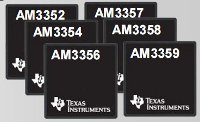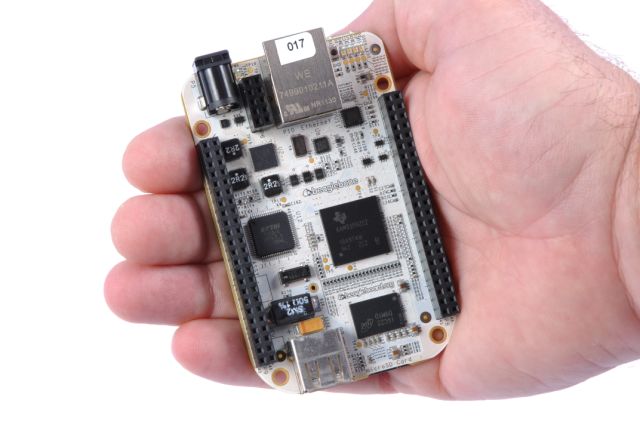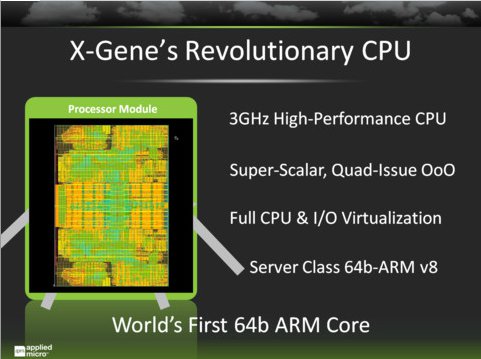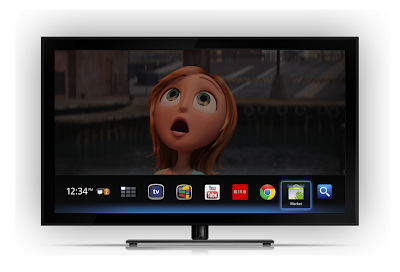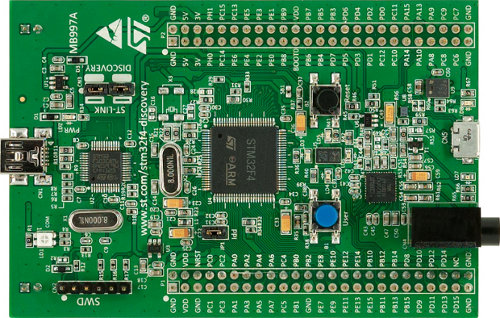Texas Instruments has just announced the new Sitara AM335X Processors and the low cost Beaglebone development board. The low cost Cortex-A8 SoCs start at 5 US dollars per piece and are aimed at upgrading ARM9 solutions (software compatible) and adding new features such as 3D interfaces and touch screen, high resolution displays with faster performance. Texas Instruments says you could take those new upgraded products to market within 6 months thanks to their inexpensive development board (Beaglebone) and complete SDK. There are six models in the Sitara AM335X series: AM3552: Cortex A8 up to 720 MHz. AM3554: Cortex A8 up to 720 MHz with 3D Graphics (PowerVR SGX GPU). AM3556: Cortex A8 up to 720 MHz with programmable real-time unit (PRU) @ 200 Mhz. AM3557: Cortex A8 up to 720 MHz with PRU @ 200Mhz and EtherCat. AM3558: Cortex A8 up to 720 MHz with 3D Graphics and PRU @ […]
BeagleBone: New 89 USD Beagleboard
The BeagleBone is a low-cost, high-expansion hardware-hacker focused BeagleBoard. It is a bare-bones BeagleBoard that acts as a USB or Ethernet connected expansion companion for your current BeagleBoard and BeagleBoard-xM or works stand-alone. The BeagleBone is smaller than the previous version of BeagleBoards (looks like the business of a credit card) and features TI Sitara™ AM3358 Cortex A8 processor clocked at 700Mhz. The BeagleBone is also able to run a full-featured Linux. Here are the current hardware specifications: TI AM3358 ARM Cortex-A8 @ 700 MHz 256 MB DDR2 RAM Board size: 3.4″ x 2.1″ Shipped with 2GB microSD card with the Angstrom Distribution with node.js and Cloud9 IDE Single cable development environment with built-in FTDI-based serial/JTAG and on-board hub to give the same cable simultaneous access to a USB device port on the target processor Industry standard 3.3V I/Os on the expansion headers with easy-to-use 0.1″ spacing On-chip Ethernet, not […]
Applied Micro X-Gene 64-Bit ARMv8 Server-on-Chip Presentation
Applied Micro Showcases World’s First 64-bit ARMv8 Core at ARM Techcon 2011, Santa Clara California. The day ARM announced the first 64-bit ARMv8 instruction set architecture, AppliedMicro unveiled the launch of the industry’s first 64-bit ARM “Server-on-a-Chip” solution. Most of the presentation is used to explain the competitive advantage this platform would bring including TCO reduced by 30%. There is also an (underwhelming) demonstration of X-Gene based on Xilinx Virtex-6 FPGA running Server SoC consisting of ARM-64 CPU complex, coherent CPU fabric, high performance I/O network, memory subsystem along with fully functional SoC subsystem. The FPGA platform and tools will be available for customer evaluation by the first half of 2012. Redhat will be in charge of implementing ARMv8 support in Linux and this will be part of Fedora for ARM in the future. The platform will run LAMP: Linux, Apache, MySQL and Perl/PHP/Python. The silicon will be available in […]
MHL (Mobile High Definition Link) Turns Your Phone into a Set-Top Box, Game Console and more
MHL (Mobile High Definition Link) was introduced at Mobile World Conference 2011, some progress has been done since then. For now Two HDTVs are MHL compliant: the Toshiba WL800A and the Samsung UN46D7000. The Toshiba TV already have a firmware upgrade that provides MHL support, a firmware upgrade will come later for the Samsung HDTV. MHL provides market disruptive features that such as the ability to charging MHL compliant phones and tablets, control them with the TV remote through one simple MHL connector (micro-USB to HDMI). In the demo below, they show the phone connected to the Toshiba WL800A and being controlled with the TV remote control to play videos (including trick modes: pause, ffwd, etc..), play Android games and use a web browser. Once you install Google TV 2.0 in your phone (you’ll probably need Android 4.0) or tablet, you can get a great TV experience via your mobile […]
Run 2 OS Simultaneously on ARM (OMAP4) with Codezero Embedded Hypervisor
B Labs, a company specializing in ARM Virtualization, was at ARM Techcon 2011 showcasing Codezero, their Embedded Hypervisor to run multiple Linux OS such as Android and Chrome OS on ARM processors. The main purpose of running 2 operating systems is to separate home and enterprise operating systems in mobile devices so that enterprise data is safe. Charbax (ARMDevices.net) interviewed Bahadir Baldan, founder of B Labs, and showed a demo running 2 Android instances and another running Android and Linux in pandaboard. The overhead is 10 to 15% according to B Labs, so the performance hit is minimal. They have already managed to run 4 OS on quad core processors with good performance. They are not able to run Windows operating systems (e.g. Windows Mobile 7.5/ Windows 8) yet, because Cortex A9 processors lack virtualization extensions. This will however be feasible with Cortex A15 processors as binary virtualization will be available. […]
Google TV 2.0 For Android 3.1 Released
Back in August, Google released a Preview of Google TV Add-on for the Android SDK. Google has now announced a software upgrade for Google TV a software running on Android device (Smart TV / STB) such as the Sony NSX-24GT1 Google TV that bring web video (e.g. YouTube, Netflix and more) to the TV. Google admits the initial version of Google TV wasn’t perfect and they even asked partners not to show product with Google TV at CES 2011. Let’s see what improvements Google TV 2.0: 1. Keep it simple The interface is now much simpler. The new customizable home screen gets you to your favorite content quickly. And within “all apps” you can see all of your shortcuts, similar to your Android phone or tablet. 2. Make it easy to find something worth watching Search has been improved across the board for content from Live TV, Netflix, YouTube, HBO […]
Display Multiplication Table With A Command Line
If you forgot your multiplication table and happen to have a terminal window opened in Linux at the time, here’s the command to use: seq 9 | sed ‘H;g’ | awk -v RS=” ‘{for(i=1;i<=NF;i++)printf(“%dx%d=%d%s”, i, NR, i*NR, i==NR?”\n”:”\t”)}’ Same thing using perl:
|
1 |
perl -e 'print join "\n", map {$a=$_;join "\t",map {$_."x$a=".$a*$_} (1 .. $a) } (1 .. 9)' |
Here’s the output:
|
1 2 3 4 5 6 7 8 9 |
1x1=1 1x2=2 2x2=4 1x3=3 2x3=6 3x3=9 1x4=4 2x4=8 3x4=12 4x4=16 1x5=5 2x5=10 3x5=15 4x5=20 5x5=25 1x6=6 2x6=12 3x6=18 4x6=24 5x6=30 6x6=36 1x7=7 2x7=14 3x7=21 4x7=28 5x7=35 6x7=42 7x7=49 1x8=8 2x8=16 3x8=24 4x8=32 5x8=40 6x8=48 7x8=56 8x8=64 1x9=9 2x9=18 3x9=27 4x9=36 5x9=45 6x9=54 7x9=63 8x9=72 9x9=81 |
Source (in French): http://www.tux-planet.fr/afficher-les-tables-de-multiplication-en-ligne-de-commande/ Jean-Luc Aufranc (CNXSoft)Jean-Luc started CNX Software in 2010 as a part-time endeavor, before quitting his job as a software engineering manager, and starting to write daily news, and reviews full time later in 2011. www.cnx-software.com
ST Micro 15 USD STM32F4-Discovery Cortex-M Development Kit
ST Microelectonics promote their Cortex-M series at ARM Techcon 2011 and especially the new STM32F4 series the most powerful cortex M4 MCUs. They also showcase a low cost development board called STM32F4-Discovery that they give away at the exhibition and that can be bought online for 14.90USD from distributors. The evaluation board is based on the STM32F407VGT6 and includes an ST-LINK/V2 embedded debug tool, two ST MEMS, digital accelerometer and digital microphone, one audio DAC with integrated class D speaker driver, LEDs and push buttons and an USB OTG micro-AB connector. A large number of free ready-to-run application firmware examples are available in the STM32F4-Discovery board firmware package to support quick evaluation and development. Key Features of the Development kit: STM32F407VGT6 microcontroller featuring 32-bit ARM Cortex-M4F core, 1 MB Flash, 192 KB RAM in an LQFP100 package On-board ST-LINK/V2 with selection mode switch to use the kit as a standalone ST-LINK/V2 […]


